Analysis and Solutions for Business Problems: A Detailed Report
VerifiedAdded on 2020/11/23
|9
|2135
|101
Report
AI Summary
This report analyzes the problem of employee turnover within a business environment. It begins by identifying the issue of high staff turnover and its impact on the organization. The report then delves into the analysis and diagnosis of the problem, exploring potential causes such as unmet job expectations and work-life imbalance. The report then proposes solutions, including promoting a good work-life balance, providing training, and offering fair compensation. The report outlines a plan to address the problem, including strategies for motivation, training, and allocation of duties. The report also discusses the importance of monitoring progress, making adjustments to the plan as needed, and considering alternative approaches to problem-solving. The conclusion summarizes the findings and emphasizes the importance of effective problem-solving in the business environment. The report references relevant academic sources to support its analysis and recommendations.
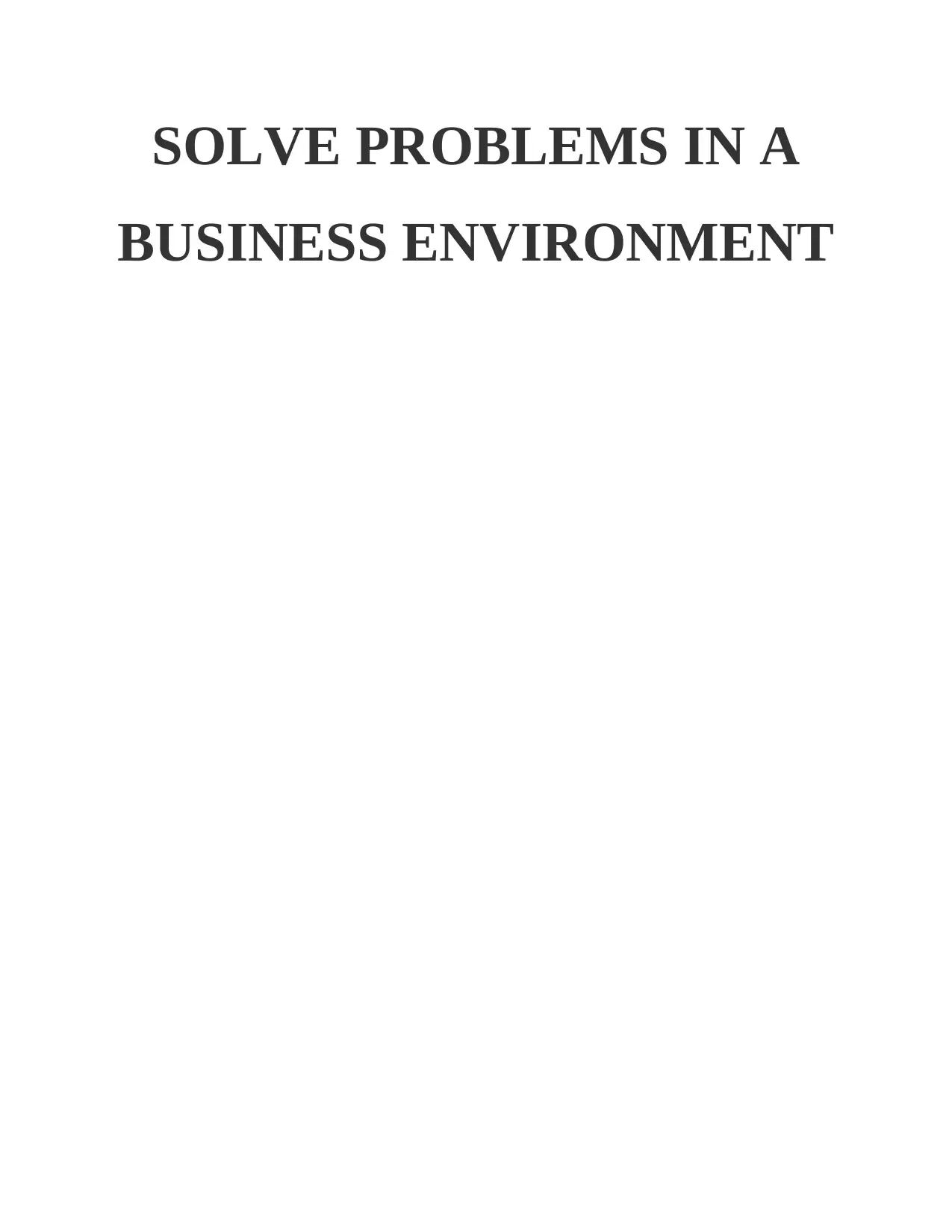
SOLVE PROBLEMS IN A
BUSINESS ENVIRONMENT
BUSINESS ENVIRONMENT
Paraphrase This Document
Need a fresh take? Get an instant paraphrase of this document with our AI Paraphraser
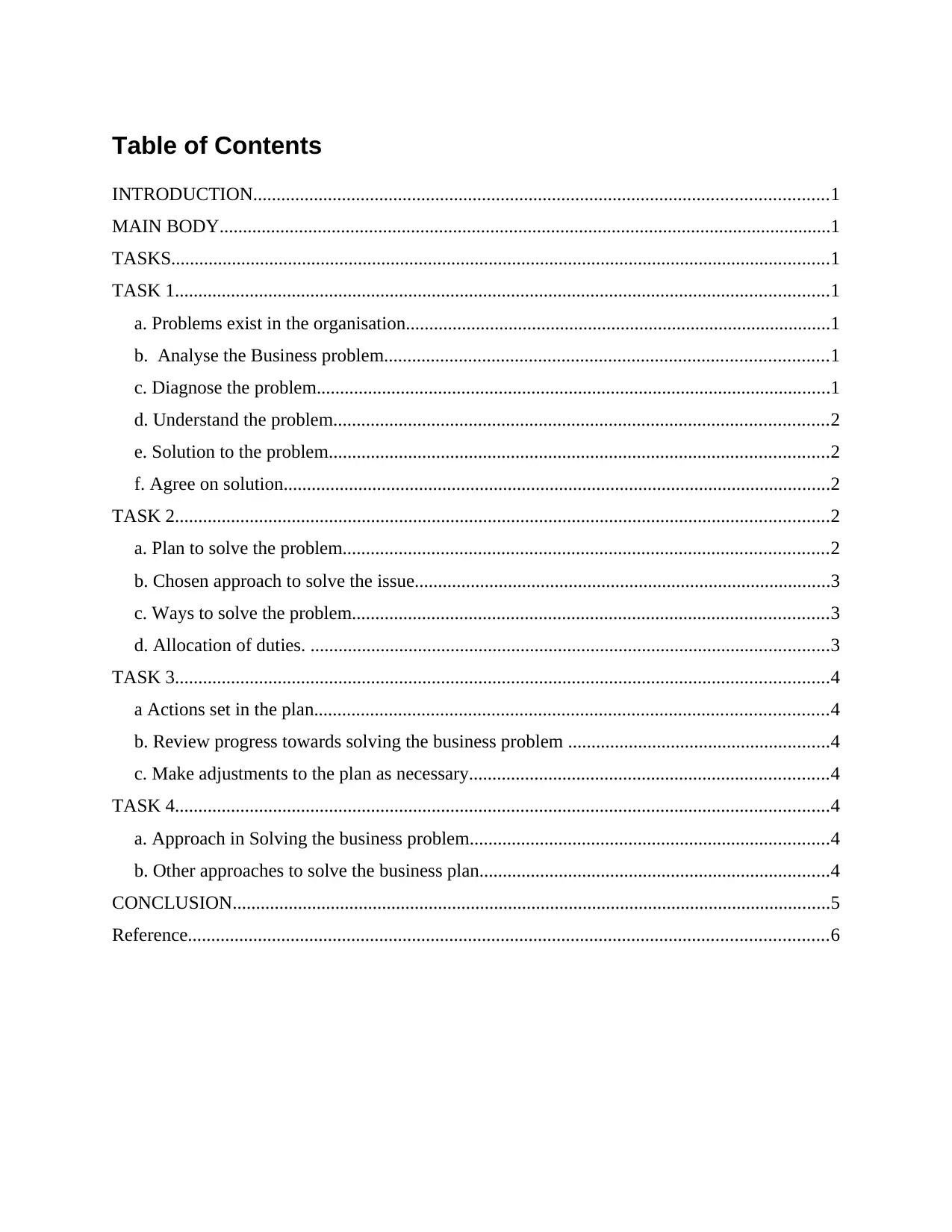
Table of Contents
INTRODUCTION...........................................................................................................................1
MAIN BODY...................................................................................................................................1
TASKS.............................................................................................................................................1
TASK 1............................................................................................................................................1
a. Problems exist in the organisation...........................................................................................1
b. Analyse the Business problem...............................................................................................1
c. Diagnose the problem..............................................................................................................1
d. Understand the problem..........................................................................................................2
e. Solution to the problem...........................................................................................................2
f. Agree on solution.....................................................................................................................2
TASK 2............................................................................................................................................2
a. Plan to solve the problem........................................................................................................2
b. Chosen approach to solve the issue.........................................................................................3
c. Ways to solve the problem......................................................................................................3
d. Allocation of duties. ...............................................................................................................3
TASK 3............................................................................................................................................4
a Actions set in the plan..............................................................................................................4
b. Review progress towards solving the business problem ........................................................4
c. Make adjustments to the plan as necessary.............................................................................4
TASK 4............................................................................................................................................4
a. Approach in Solving the business problem.............................................................................4
b. Other approaches to solve the business plan...........................................................................4
CONCLUSION................................................................................................................................5
Reference.........................................................................................................................................6
INTRODUCTION...........................................................................................................................1
MAIN BODY...................................................................................................................................1
TASKS.............................................................................................................................................1
TASK 1............................................................................................................................................1
a. Problems exist in the organisation...........................................................................................1
b. Analyse the Business problem...............................................................................................1
c. Diagnose the problem..............................................................................................................1
d. Understand the problem..........................................................................................................2
e. Solution to the problem...........................................................................................................2
f. Agree on solution.....................................................................................................................2
TASK 2............................................................................................................................................2
a. Plan to solve the problem........................................................................................................2
b. Chosen approach to solve the issue.........................................................................................3
c. Ways to solve the problem......................................................................................................3
d. Allocation of duties. ...............................................................................................................3
TASK 3............................................................................................................................................4
a Actions set in the plan..............................................................................................................4
b. Review progress towards solving the business problem ........................................................4
c. Make adjustments to the plan as necessary.............................................................................4
TASK 4............................................................................................................................................4
a. Approach in Solving the business problem.............................................................................4
b. Other approaches to solve the business plan...........................................................................4
CONCLUSION................................................................................................................................5
Reference.........................................................................................................................................6
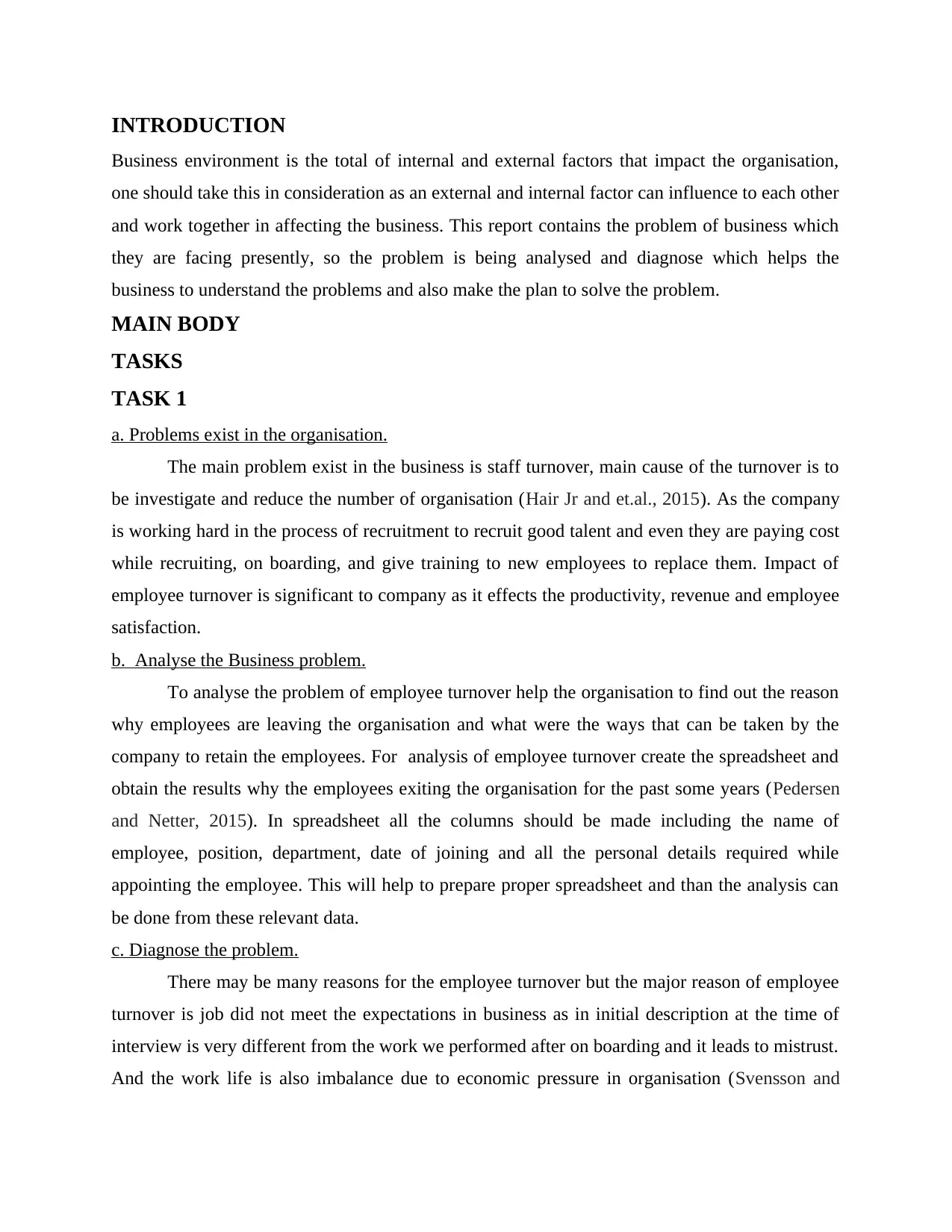
INTRODUCTION
Business environment is the total of internal and external factors that impact the organisation,
one should take this in consideration as an external and internal factor can influence to each other
and work together in affecting the business. This report contains the problem of business which
they are facing presently, so the problem is being analysed and diagnose which helps the
business to understand the problems and also make the plan to solve the problem.
MAIN BODY
TASKS
TASK 1
a. Problems exist in the organisation.
The main problem exist in the business is staff turnover, main cause of the turnover is to
be investigate and reduce the number of organisation (Hair Jr and et.al., 2015). As the company
is working hard in the process of recruitment to recruit good talent and even they are paying cost
while recruiting, on boarding, and give training to new employees to replace them. Impact of
employee turnover is significant to company as it effects the productivity, revenue and employee
satisfaction.
b. Analyse the Business problem.
To analyse the problem of employee turnover help the organisation to find out the reason
why employees are leaving the organisation and what were the ways that can be taken by the
company to retain the employees. For analysis of employee turnover create the spreadsheet and
obtain the results why the employees exiting the organisation for the past some years (Pedersen
and Netter, 2015). In spreadsheet all the columns should be made including the name of
employee, position, department, date of joining and all the personal details required while
appointing the employee. This will help to prepare proper spreadsheet and than the analysis can
be done from these relevant data.
c. Diagnose the problem.
There may be many reasons for the employee turnover but the major reason of employee
turnover is job did not meet the expectations in business as in initial description at the time of
interview is very different from the work we performed after on boarding and it leads to mistrust.
And the work life is also imbalance due to economic pressure in organisation (Svensson and
Business environment is the total of internal and external factors that impact the organisation,
one should take this in consideration as an external and internal factor can influence to each other
and work together in affecting the business. This report contains the problem of business which
they are facing presently, so the problem is being analysed and diagnose which helps the
business to understand the problems and also make the plan to solve the problem.
MAIN BODY
TASKS
TASK 1
a. Problems exist in the organisation.
The main problem exist in the business is staff turnover, main cause of the turnover is to
be investigate and reduce the number of organisation (Hair Jr and et.al., 2015). As the company
is working hard in the process of recruitment to recruit good talent and even they are paying cost
while recruiting, on boarding, and give training to new employees to replace them. Impact of
employee turnover is significant to company as it effects the productivity, revenue and employee
satisfaction.
b. Analyse the Business problem.
To analyse the problem of employee turnover help the organisation to find out the reason
why employees are leaving the organisation and what were the ways that can be taken by the
company to retain the employees. For analysis of employee turnover create the spreadsheet and
obtain the results why the employees exiting the organisation for the past some years (Pedersen
and Netter, 2015). In spreadsheet all the columns should be made including the name of
employee, position, department, date of joining and all the personal details required while
appointing the employee. This will help to prepare proper spreadsheet and than the analysis can
be done from these relevant data.
c. Diagnose the problem.
There may be many reasons for the employee turnover but the major reason of employee
turnover is job did not meet the expectations in business as in initial description at the time of
interview is very different from the work we performed after on boarding and it leads to mistrust.
And the work life is also imbalance due to economic pressure in organisation (Svensson and
⊘ This is a preview!⊘
Do you want full access?
Subscribe today to unlock all pages.

Trusted by 1+ million students worldwide
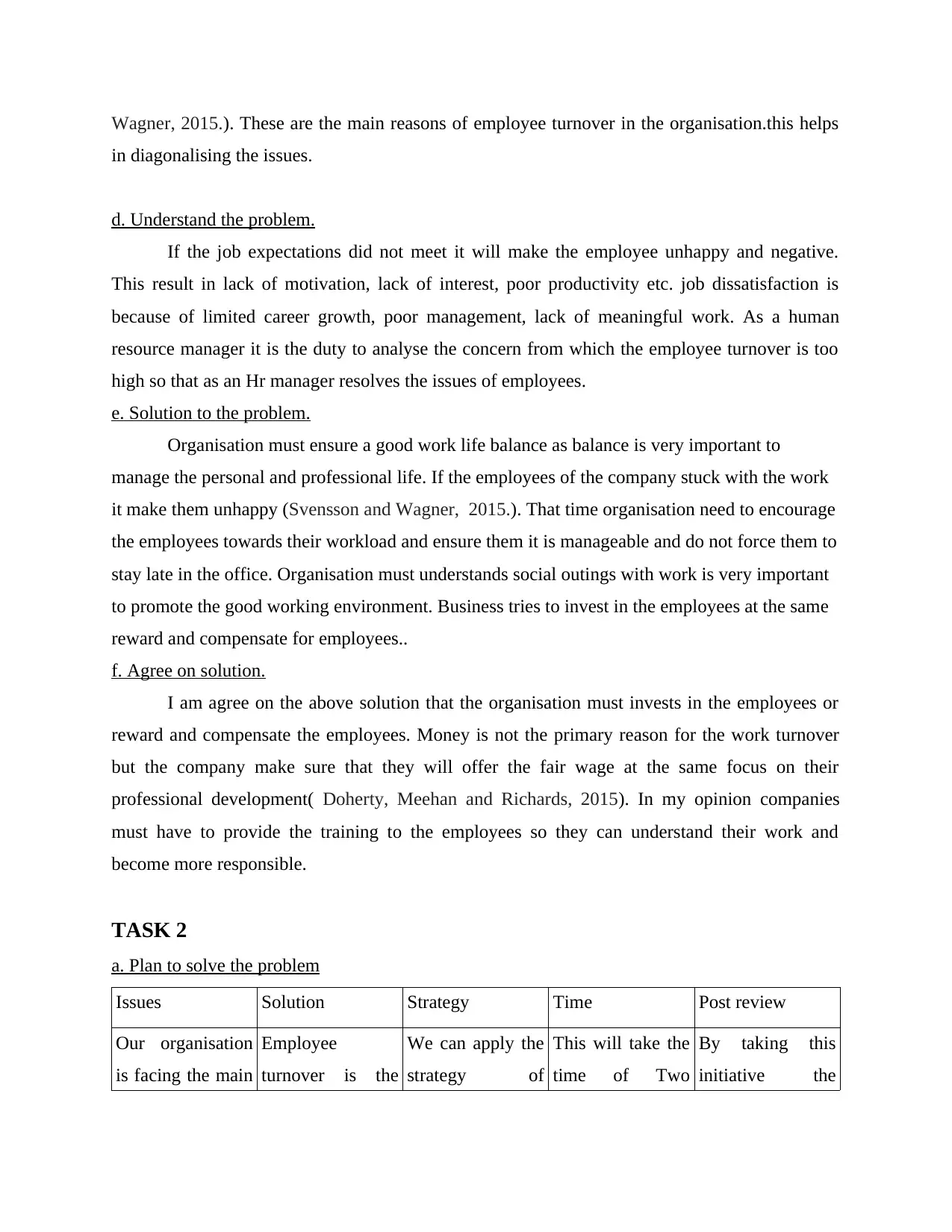
Wagner, 2015.). These are the main reasons of employee turnover in the organisation.this helps
in diagonalising the issues.
d. Understand the problem.
If the job expectations did not meet it will make the employee unhappy and negative.
This result in lack of motivation, lack of interest, poor productivity etc. job dissatisfaction is
because of limited career growth, poor management, lack of meaningful work. As a human
resource manager it is the duty to analyse the concern from which the employee turnover is too
high so that as an Hr manager resolves the issues of employees.
e. Solution to the problem.
Organisation must ensure a good work life balance as balance is very important to
manage the personal and professional life. If the employees of the company stuck with the work
it make them unhappy (Svensson and Wagner, 2015.). That time organisation need to encourage
the employees towards their workload and ensure them it is manageable and do not force them to
stay late in the office. Organisation must understands social outings with work is very important
to promote the good working environment. Business tries to invest in the employees at the same
reward and compensate for employees..
f. Agree on solution.
I am agree on the above solution that the organisation must invests in the employees or
reward and compensate the employees. Money is not the primary reason for the work turnover
but the company make sure that they will offer the fair wage at the same focus on their
professional development( Doherty, Meehan and Richards, 2015). In my opinion companies
must have to provide the training to the employees so they can understand their work and
become more responsible.
TASK 2
a. Plan to solve the problem
Issues Solution Strategy Time Post review
Our organisation
is facing the main
Employee
turnover is the
We can apply the
strategy of
This will take the
time of Two
By taking this
initiative the
in diagonalising the issues.
d. Understand the problem.
If the job expectations did not meet it will make the employee unhappy and negative.
This result in lack of motivation, lack of interest, poor productivity etc. job dissatisfaction is
because of limited career growth, poor management, lack of meaningful work. As a human
resource manager it is the duty to analyse the concern from which the employee turnover is too
high so that as an Hr manager resolves the issues of employees.
e. Solution to the problem.
Organisation must ensure a good work life balance as balance is very important to
manage the personal and professional life. If the employees of the company stuck with the work
it make them unhappy (Svensson and Wagner, 2015.). That time organisation need to encourage
the employees towards their workload and ensure them it is manageable and do not force them to
stay late in the office. Organisation must understands social outings with work is very important
to promote the good working environment. Business tries to invest in the employees at the same
reward and compensate for employees..
f. Agree on solution.
I am agree on the above solution that the organisation must invests in the employees or
reward and compensate the employees. Money is not the primary reason for the work turnover
but the company make sure that they will offer the fair wage at the same focus on their
professional development( Doherty, Meehan and Richards, 2015). In my opinion companies
must have to provide the training to the employees so they can understand their work and
become more responsible.
TASK 2
a. Plan to solve the problem
Issues Solution Strategy Time Post review
Our organisation
is facing the main
Employee
turnover is the
We can apply the
strategy of
This will take the
time of Two
By taking this
initiative the
Paraphrase This Document
Need a fresh take? Get an instant paraphrase of this document with our AI Paraphraser
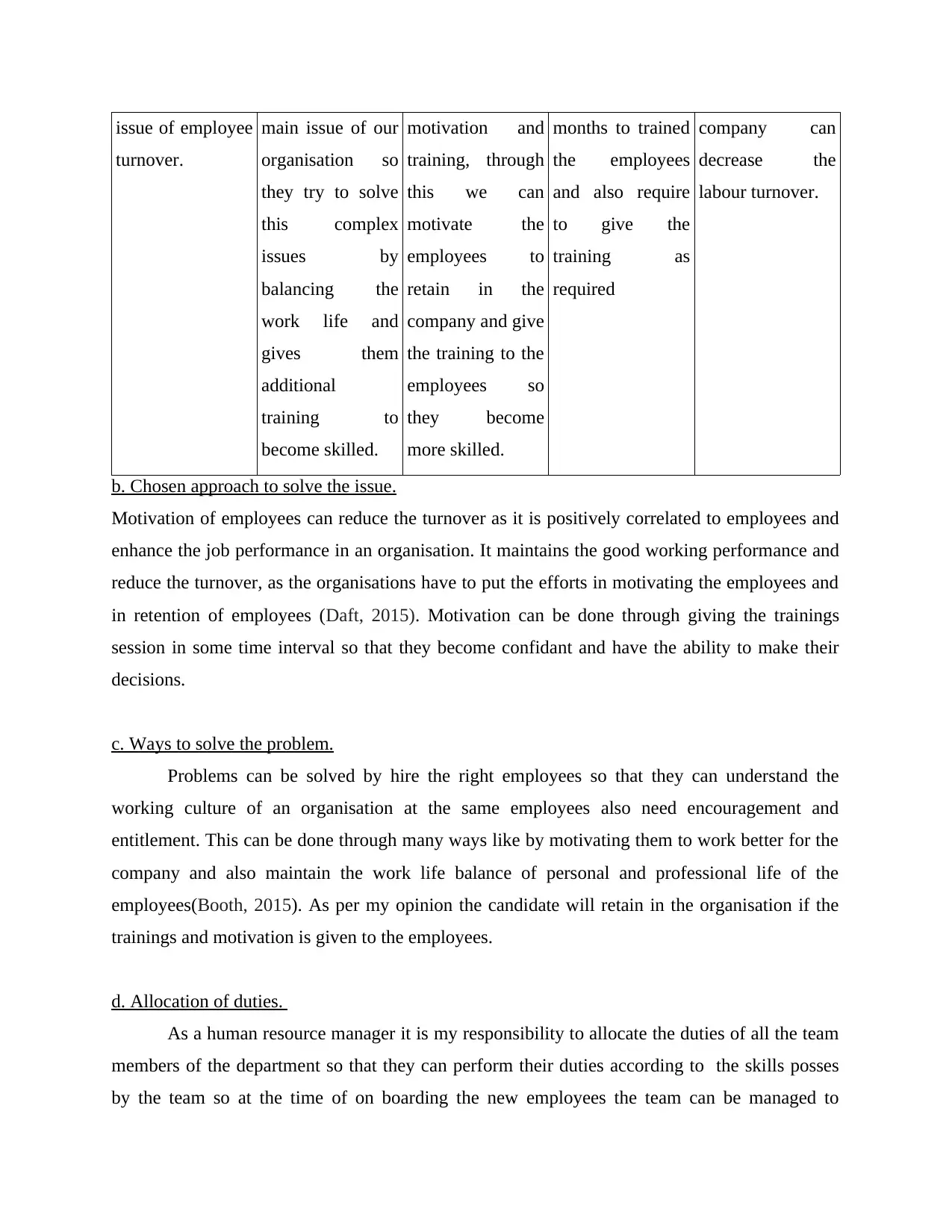
issue of employee
turnover.
main issue of our
organisation so
they try to solve
this complex
issues by
balancing the
work life and
gives them
additional
training to
become skilled.
motivation and
training, through
this we can
motivate the
employees to
retain in the
company and give
the training to the
employees so
they become
more skilled.
months to trained
the employees
and also require
to give the
training as
required
company can
decrease the
labour turnover.
b. Chosen approach to solve the issue.
Motivation of employees can reduce the turnover as it is positively correlated to employees and
enhance the job performance in an organisation. It maintains the good working performance and
reduce the turnover, as the organisations have to put the efforts in motivating the employees and
in retention of employees (Daft, 2015). Motivation can be done through giving the trainings
session in some time interval so that they become confidant and have the ability to make their
decisions.
c. Ways to solve the problem.
Problems can be solved by hire the right employees so that they can understand the
working culture of an organisation at the same employees also need encouragement and
entitlement. This can be done through many ways like by motivating them to work better for the
company and also maintain the work life balance of personal and professional life of the
employees(Booth, 2015). As per my opinion the candidate will retain in the organisation if the
trainings and motivation is given to the employees.
d. Allocation of duties.
As a human resource manager it is my responsibility to allocate the duties of all the team
members of the department so that they can perform their duties according to the skills posses
by the team so at the time of on boarding the new employees the team can be managed to
turnover.
main issue of our
organisation so
they try to solve
this complex
issues by
balancing the
work life and
gives them
additional
training to
become skilled.
motivation and
training, through
this we can
motivate the
employees to
retain in the
company and give
the training to the
employees so
they become
more skilled.
months to trained
the employees
and also require
to give the
training as
required
company can
decrease the
labour turnover.
b. Chosen approach to solve the issue.
Motivation of employees can reduce the turnover as it is positively correlated to employees and
enhance the job performance in an organisation. It maintains the good working performance and
reduce the turnover, as the organisations have to put the efforts in motivating the employees and
in retention of employees (Daft, 2015). Motivation can be done through giving the trainings
session in some time interval so that they become confidant and have the ability to make their
decisions.
c. Ways to solve the problem.
Problems can be solved by hire the right employees so that they can understand the
working culture of an organisation at the same employees also need encouragement and
entitlement. This can be done through many ways like by motivating them to work better for the
company and also maintain the work life balance of personal and professional life of the
employees(Booth, 2015). As per my opinion the candidate will retain in the organisation if the
trainings and motivation is given to the employees.
d. Allocation of duties.
As a human resource manager it is my responsibility to allocate the duties of all the team
members of the department so that they can perform their duties according to the skills posses
by the team so at the time of on boarding the new employees the team can be managed to
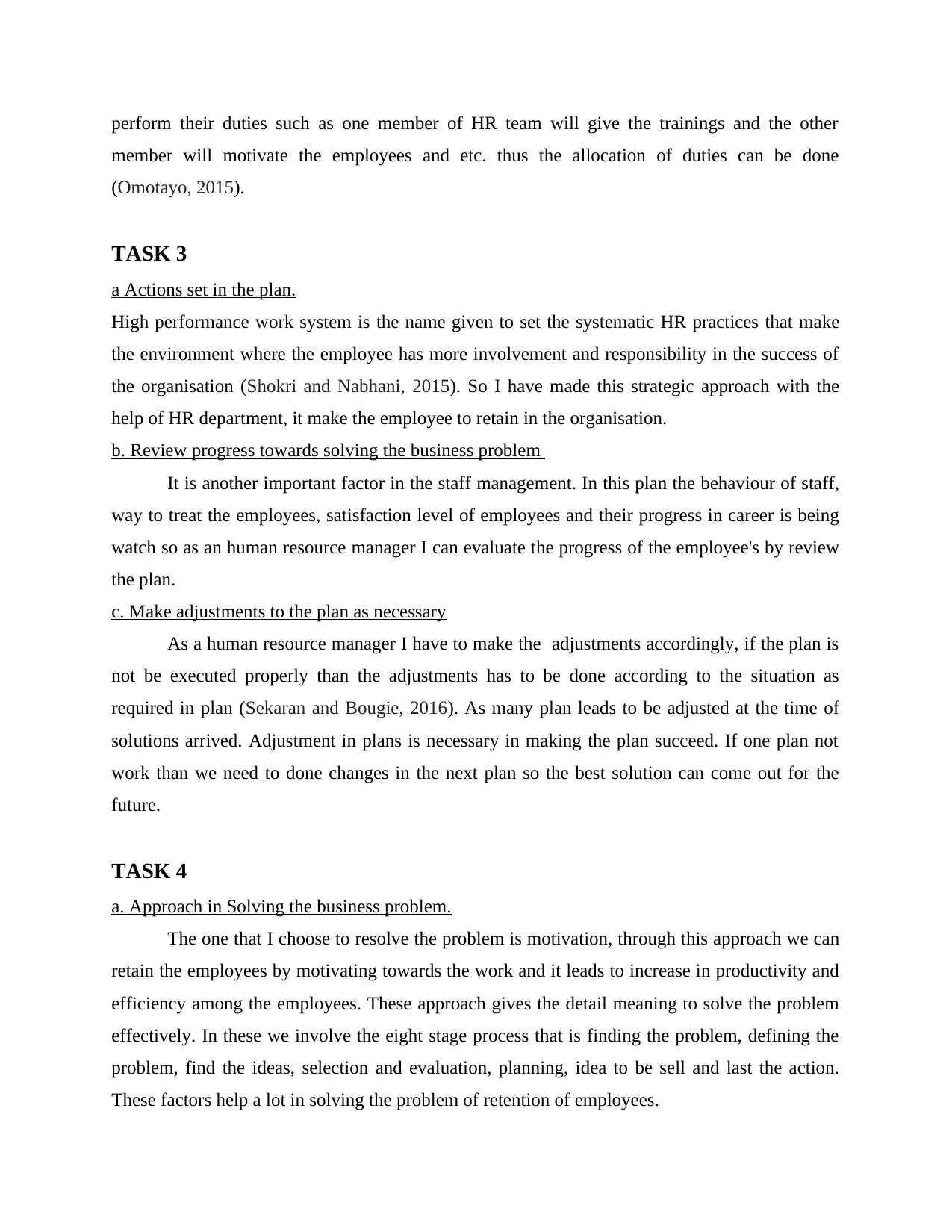
perform their duties such as one member of HR team will give the trainings and the other
member will motivate the employees and etc. thus the allocation of duties can be done
(Omotayo, 2015).
TASK 3
a Actions set in the plan.
High performance work system is the name given to set the systematic HR practices that make
the environment where the employee has more involvement and responsibility in the success of
the organisation (Shokri and Nabhani, 2015). So I have made this strategic approach with the
help of HR department, it make the employee to retain in the organisation.
b. Review progress towards solving the business problem
It is another important factor in the staff management. In this plan the behaviour of staff,
way to treat the employees, satisfaction level of employees and their progress in career is being
watch so as an human resource manager I can evaluate the progress of the employee's by review
the plan.
c. Make adjustments to the plan as necessary
As a human resource manager I have to make the adjustments accordingly, if the plan is
not be executed properly than the adjustments has to be done according to the situation as
required in plan (Sekaran and Bougie, 2016). As many plan leads to be adjusted at the time of
solutions arrived. Adjustment in plans is necessary in making the plan succeed. If one plan not
work than we need to done changes in the next plan so the best solution can come out for the
future.
TASK 4
a. Approach in Solving the business problem.
The one that I choose to resolve the problem is motivation, through this approach we can
retain the employees by motivating towards the work and it leads to increase in productivity and
efficiency among the employees. These approach gives the detail meaning to solve the problem
effectively. In these we involve the eight stage process that is finding the problem, defining the
problem, find the ideas, selection and evaluation, planning, idea to be sell and last the action.
These factors help a lot in solving the problem of retention of employees.
member will motivate the employees and etc. thus the allocation of duties can be done
(Omotayo, 2015).
TASK 3
a Actions set in the plan.
High performance work system is the name given to set the systematic HR practices that make
the environment where the employee has more involvement and responsibility in the success of
the organisation (Shokri and Nabhani, 2015). So I have made this strategic approach with the
help of HR department, it make the employee to retain in the organisation.
b. Review progress towards solving the business problem
It is another important factor in the staff management. In this plan the behaviour of staff,
way to treat the employees, satisfaction level of employees and their progress in career is being
watch so as an human resource manager I can evaluate the progress of the employee's by review
the plan.
c. Make adjustments to the plan as necessary
As a human resource manager I have to make the adjustments accordingly, if the plan is
not be executed properly than the adjustments has to be done according to the situation as
required in plan (Sekaran and Bougie, 2016). As many plan leads to be adjusted at the time of
solutions arrived. Adjustment in plans is necessary in making the plan succeed. If one plan not
work than we need to done changes in the next plan so the best solution can come out for the
future.
TASK 4
a. Approach in Solving the business problem.
The one that I choose to resolve the problem is motivation, through this approach we can
retain the employees by motivating towards the work and it leads to increase in productivity and
efficiency among the employees. These approach gives the detail meaning to solve the problem
effectively. In these we involve the eight stage process that is finding the problem, defining the
problem, find the ideas, selection and evaluation, planning, idea to be sell and last the action.
These factors help a lot in solving the problem of retention of employees.
⊘ This is a preview!⊘
Do you want full access?
Subscribe today to unlock all pages.

Trusted by 1+ million students worldwide
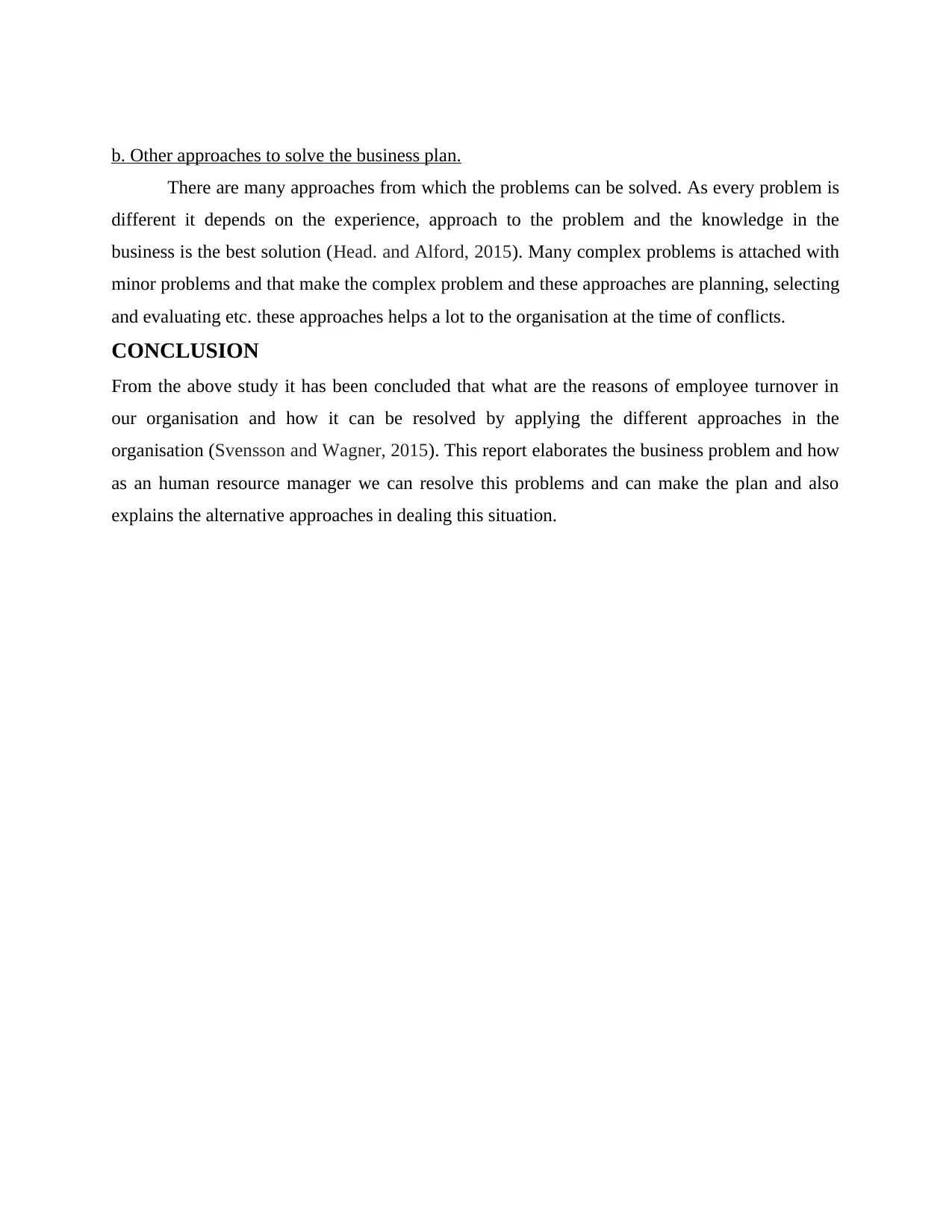
b. Other approaches to solve the business plan.
There are many approaches from which the problems can be solved. As every problem is
different it depends on the experience, approach to the problem and the knowledge in the
business is the best solution (Head. and Alford, 2015). Many complex problems is attached with
minor problems and that make the complex problem and these approaches are planning, selecting
and evaluating etc. these approaches helps a lot to the organisation at the time of conflicts.
CONCLUSION
From the above study it has been concluded that what are the reasons of employee turnover in
our organisation and how it can be resolved by applying the different approaches in the
organisation (Svensson and Wagner, 2015). This report elaborates the business problem and how
as an human resource manager we can resolve this problems and can make the plan and also
explains the alternative approaches in dealing this situation.
There are many approaches from which the problems can be solved. As every problem is
different it depends on the experience, approach to the problem and the knowledge in the
business is the best solution (Head. and Alford, 2015). Many complex problems is attached with
minor problems and that make the complex problem and these approaches are planning, selecting
and evaluating etc. these approaches helps a lot to the organisation at the time of conflicts.
CONCLUSION
From the above study it has been concluded that what are the reasons of employee turnover in
our organisation and how it can be resolved by applying the different approaches in the
organisation (Svensson and Wagner, 2015). This report elaborates the business problem and how
as an human resource manager we can resolve this problems and can make the plan and also
explains the alternative approaches in dealing this situation.
Paraphrase This Document
Need a fresh take? Get an instant paraphrase of this document with our AI Paraphraser
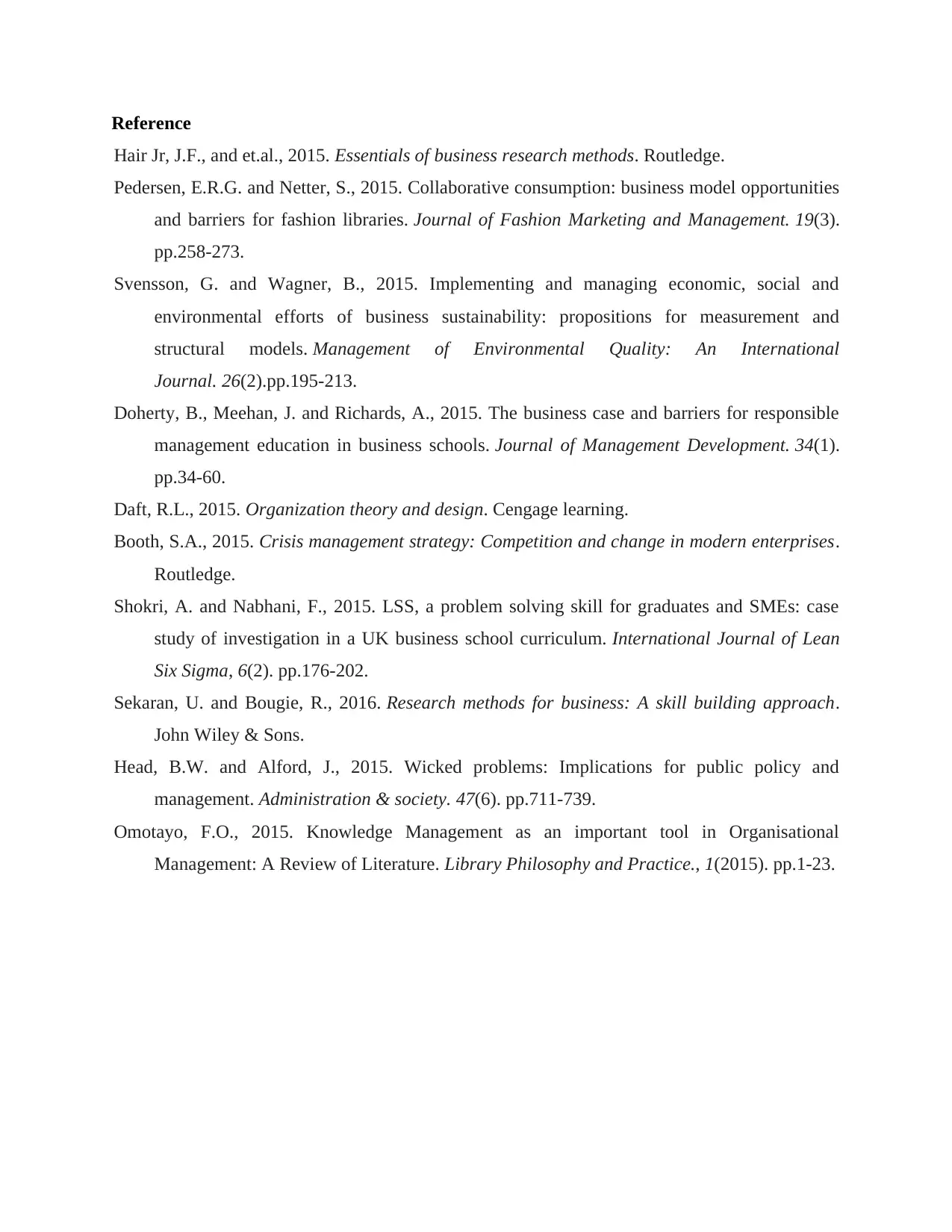
Reference
Hair Jr, J.F., and et.al., 2015. Essentials of business research methods. Routledge.
Pedersen, E.R.G. and Netter, S., 2015. Collaborative consumption: business model opportunities
and barriers for fashion libraries. Journal of Fashion Marketing and Management. 19(3).
pp.258-273.
Svensson, G. and Wagner, B., 2015. Implementing and managing economic, social and
environmental efforts of business sustainability: propositions for measurement and
structural models. Management of Environmental Quality: An International
Journal. 26(2).pp.195-213.
Doherty, B., Meehan, J. and Richards, A., 2015. The business case and barriers for responsible
management education in business schools. Journal of Management Development. 34(1).
pp.34-60.
Daft, R.L., 2015. Organization theory and design. Cengage learning.
Booth, S.A., 2015. Crisis management strategy: Competition and change in modern enterprises.
Routledge.
Shokri, A. and Nabhani, F., 2015. LSS, a problem solving skill for graduates and SMEs: case
study of investigation in a UK business school curriculum. International Journal of Lean
Six Sigma, 6(2). pp.176-202.
Sekaran, U. and Bougie, R., 2016. Research methods for business: A skill building approach.
John Wiley & Sons.
Head, B.W. and Alford, J., 2015. Wicked problems: Implications for public policy and
management. Administration & society. 47(6). pp.711-739.
Omotayo, F.O., 2015. Knowledge Management as an important tool in Organisational
Management: A Review of Literature. Library Philosophy and Practice., 1(2015). pp.1-23.
Hair Jr, J.F., and et.al., 2015. Essentials of business research methods. Routledge.
Pedersen, E.R.G. and Netter, S., 2015. Collaborative consumption: business model opportunities
and barriers for fashion libraries. Journal of Fashion Marketing and Management. 19(3).
pp.258-273.
Svensson, G. and Wagner, B., 2015. Implementing and managing economic, social and
environmental efforts of business sustainability: propositions for measurement and
structural models. Management of Environmental Quality: An International
Journal. 26(2).pp.195-213.
Doherty, B., Meehan, J. and Richards, A., 2015. The business case and barriers for responsible
management education in business schools. Journal of Management Development. 34(1).
pp.34-60.
Daft, R.L., 2015. Organization theory and design. Cengage learning.
Booth, S.A., 2015. Crisis management strategy: Competition and change in modern enterprises.
Routledge.
Shokri, A. and Nabhani, F., 2015. LSS, a problem solving skill for graduates and SMEs: case
study of investigation in a UK business school curriculum. International Journal of Lean
Six Sigma, 6(2). pp.176-202.
Sekaran, U. and Bougie, R., 2016. Research methods for business: A skill building approach.
John Wiley & Sons.
Head, B.W. and Alford, J., 2015. Wicked problems: Implications for public policy and
management. Administration & society. 47(6). pp.711-739.
Omotayo, F.O., 2015. Knowledge Management as an important tool in Organisational
Management: A Review of Literature. Library Philosophy and Practice., 1(2015). pp.1-23.

⊘ This is a preview!⊘
Do you want full access?
Subscribe today to unlock all pages.

Trusted by 1+ million students worldwide
1 out of 9
Related Documents
Your All-in-One AI-Powered Toolkit for Academic Success.
+13062052269
info@desklib.com
Available 24*7 on WhatsApp / Email
![[object Object]](/_next/static/media/star-bottom.7253800d.svg)
Unlock your academic potential
Copyright © 2020–2025 A2Z Services. All Rights Reserved. Developed and managed by ZUCOL.





